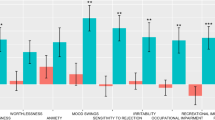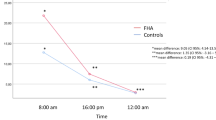Abstract
Most prior studies in patients with premenstrual dysphoric disorder (PMDD) indicate a blunted hypothalamus–pituitary–adrenal axis function. However, the relationship between neuroactive progesterone metabolites, such as allopregnanolone, and hypothalamus–pituitary–adrenal (HPA) axis function in PMDD patients is relatively sparsely studied. The primary aims of this study were to assess diurnal variation in circulating cortisol and low-dose dexamethasone suppression in PMDD patients and healthy controls, and the relationship between these two HPA axis indices and allopregnanolone serum concentrations. Twenty-six women with prospectively defined PMDD and 30 healthy controls were recruited. Participants underwent diurnal sampling for cortisol serum concentrations and a low-dose dexamethasone suppression test. In addition, morning allopregnanolone serum concentrations were determined. There was no difference in diurnal secretion of cortisol and degree of dexamethasone suppression of cortisol between PMDD patients and healthy controls. However, PMDD patients with high allopregnanolone levels displayed blunted nocturnal cortisol levels in comparison with healthy controls who had low allopregnanolone serum concentrations. In women with PMDD, diurnal secretion of cortisol may be influenced by allopregnanolone levels of the luteal phase. This finding may be attributed to timing of blood sampling in the late luteal phase as well as the individual level of allopregnanolone but could potentially explain the discrepancies in results between studies examining HPA axis function in women with PMDD.



Similar content being viewed by others
References
Andreen L, Sundstrom-Poromaa I, Bixo M, Andersson A, Nyberg S, Backstrom T (2005) Relationship between allopregnanolone and negative mood in postmenopausal women taking sequential hormone replacement therapy with vaginal progesterone. Psychoneuroendocrinology 30:212–224
Andreen L, Sundstrom-Poromaa I, Bixo M, Nyberg S, Backstrom T (2006) Allopregnanolone concentration and mood—a bimodal association in postmenopausal women treated with oral progesterone. Psychopharmacology (Berl) 187:209–221
Backstrom T, Andersson A, Andree L, Birzniece V, Bixo M, Bjorn I et al (2003) Pathogenesis in menstrual cycle-linked CNS disorders. Ann N Y Acad Sci 1007:42–53
Backstrom T, Bixo M, Nyberg S, Savic I (2012) Increased neurosteroid sensitivity—an explanation to symptoms associated with chronic work related stress in women? Psychoneuroendocrinology
Bancroft J, Cook A, Davidson D, Bennie J, Goodwin G (1991) Blunting of neuroendocrine responses to infusion of L-tryptophan in women with perimenstrual mood change. Psychol Med 21:305–312
Bloch M, Schmidt PJ, Su TP, Tobin MB, Rubinow DR (1998) Pituitary-adrenal hormones and testosterone across the menstrual cycle in women with premenstrual syndrome and controls. Biol Psychiatry 43:897–903
Brown J, OB PM, Marjoribanks J, Wyatt K (2009) Selective serotonin reuptake inhibitors for premenstrual syndrome. Cochrane Database Syst Rev CD001396
Budziszewska B, Zajac A, Basta-Kaim A, Leskiewicz M, Steczkowska M, Lason W et al (2010) Effects of neurosteroids on the human corticotropin-releasing hormone gene. Pharmacol Rep 62:1030–1040
Calogero AE, Palumbo MA, Bosboom AM, Burrello N, Ferrara E, Palumbo G et al (1998) The neuroactive steroid allopregnanolone suppresses hypothalamic gonadotropin-releasing hormone release through a mechanism mediated by the gamma-aminobutyric acid A receptor. J Endocrinol 158:121–125
Corpechot C, Collins BE, Carey MP, Tsouros A, Robel P, Fry JP (1997) Brain neurosteroids during the mouse oestrous cycle. Brain Res 766:276–280
Cunningham J, Yonkers KA, O'Brien S, Eriksson E (2009) Update on research and treatment of premenstrual dysphoric disorder. Harv Rev Psychiatry 17:120–137
Epperson CN, Haga K, Mason GF, Sellers E, Gueorguieva R, Zhang W et al (2002) Cortical gamma-aminobutyric acid levels across the menstrual cycle in healthy women and those with premenstrual dysphoric disorder: a proton magnetic resonance spectroscopy study. Arch Gen Psychiatry 59:851–858
Garde AH, Hansen AM (2005) Long-term stability of salivary cortisol. Scand J Clin Lab Invest 65:433–436
Girdler SS, Klatzkin R (2007) Neurosteroids in the context of stress: implications for depressive disorders. Pharmacol Ther 116:125–139
Girdler SS, Pedersen CA, Straneva PA, Leserman J, Stanwyck CL, Benjamin S et al (1998) Dysregulation of cardiovascular and neuroendocrine responses to stress in premenstrual dysphoric disorder. Psychiatry Res 81:163–178
Girdler SS, Straneva PA, Light KC, Pedersen CA, Morrow AL (2001) Allopregnanolone levels and reactivity to mental stress in premenstrual dysphoric disorder. Biol Psychiatry 49:788–797
Girdler SS, Sherwood A, Hinderliter AL, Leserman J, Costello NL, Straneva PA et al (2003) Biological correlates of abuse in women with premenstrual dysphoric disorder and healthy controls. Psychosom Med 65:849–856
Guo AL, Petraglia F, Criscuolo M, Ficarra G, Nappi RE, Palumbo MA et al (1995) Evidence for a role of neurosteroids in modulation of diurnal changes and acute stress-induced corticosterone secretion in rats. Gynecol Endocrinol 9:1–7
Heim C, Newport DJ, Heit S, Graham YP, Wilcox M, Bonsall R et al (2000) Pituitary-adrenal and autonomic responses to stress in women after sexual and physical abuse in childhood. Jama 284:592–597
Heim C, Newport DJ, Bonsall R, Miller AH, Nemeroff CB (2001) Altered pituitary-adrenal axis responses to provocative challenge tests in adult survivors of childhood abuse. Am J Psychiatry 158:575–581
Jovanovic H, Cerin A, Karlsson P, Lundberg J, Halldin C, Nordstrom AL (2006) A PET study of 5-HT1A receptors at different phases of the menstrual cycle in women with premenstrual dysphoria. Psychiatry Res 148:185–193
Klatzkin RR, Lindgren ME, Forneris CA, Girdler SS (2010) Histories of major depression and premenstrual dysphoric disorder: evidence for phenotypic differences. Biol Psychol 84:235–247
Kovacs KJ, Miklos IH, Bali B (2004) GABAergic mechanisms constraining the activity of the hypothalamo-pituitary-adrenocortical axis. Ann N Y Acad Sci 1018:466–476
Levitan RD, Vaccarino FJ, Brown GM, Kennedy SH (2002) Low-dose dexamethasone challenge in women with atypical major depression: pilot study. J Psychiatry Neurosci 27:47–51
Lombardi I, Luisi S, Quirici B, Monteleone P, Bernardi F, Liut M et al (2004) Adrenal response to adrenocorticotropic hormone stimulation in patients with premenstrual syndrome. Gynecol Endocrinol 18:79–87
Ottander U, Poromaa IS, Bjurulf E, Skytt A, Backstrom T, Olofsson JI (2005) Allopregnanolone and pregnanolone are produced by the human corpus luteum. Mol Cell Endocrinol 239:37–44
Parry BL, Javeed S, Laughlin GA, Hauger R, Clopton P (2000) Cortisol circadian rhythms during the menstrual cycle and with sleep deprivation in premenstrual dysphoric disorder and normal control subjects. Biol Psychiatry 48:920–931
Patchev VK, Shoaib M, Holsboer F, Almeida OF (1994) The neurosteroid tetrahydroprogesterone counteracts corticotropin-releasing hormone-induced anxiety and alters the release and gene expression of corticotropin-releasing hormone in the rat hypothalamus. Neuroscience 62:265–271
Patchev VK, Hassan AH, Holsboer DF, Almeida OF (1996) The neurosteroid tetrahydroprogesterone attenuates the endocrine response to stress and exerts glucocorticoid-like effects on vasopressin gene transcription in the rat hypothalamus. Neuropsychopharmacology 15:533–540
Perkonigg A, Yonkers KA, Pfister H, Lieb R, Wittchen HU (2004) Risk factors for premenstrual dysphoric disorder in a community sample of young women: the role of traumatic events and posttraumatic stress disorder. J Clin Psychiatry 65:1314–1322
Rabin DS, Schmidt PJ, Campbell G, Gold PW, Jensvold M, Rubinow DR et al (1990) Hypothalamic-pituitary-adrenal function in patients with the premenstrual syndrome. J Clin Endocrinol Metab 71:1158–1162
Redei E, Freeman EW (1993) Preliminary evidence for plasma adrenocorticotropin levels as biological correlates of premenstrual symptoms. Acta Endocrinol (Copenh) 128:536–542
Roca CA, Schmidt PJ, Altemus M, Deuster P, Danaceau MA, Putnam K et al (2003) Differential menstrual cycle regulation of hypothalamic-pituitary-adrenal axis in women with premenstrual syndrome and controls. J Clin Endocrinol Metab 88:3057–3063
Sadler C, Smith H, Hammond J, Bayly R, Borland S, Panay N et al (2010) Lifestyle factors, hormonal contraception, and premenstrual symptoms: the United Kingdom Southampton Women’s Survey. J Womens Health (Larchmt) 19:391–396
Segebladh B, Borgstrom A, Nyberg S, Bixo M, Sundstrom-Poromaa I (2009) Evaluation of different add-back estradiol and progesterone treatments to gonadotropin-releasing hormone agonist treatment in patients with premenstrual dysphoric disorder. Am J Obstet Gynecol 201:139.e1–139.e8
Sheehan DV, Lecrubier Y, Sheehan KH, Amorim P, Janavs J, Weiller E et al (1998) The Mini-International Neuropsychiatric Interview (M.I.N.I.): the development and validation of a structured diagnostic psychiatric interview for DSM-IV and ICD-10. J Clin Psychiatry 59(Suppl 20):22–33, quiz 34–57
Su TP, Schmidt PJ, Danaceau M, Murphy DL, Rubinow DR (1997) Effect of menstrual cycle phase on neuroendocrine and behavioral responses to the serotonin agonist m-chlorophenylpiperazine in women with premenstrual syndrome and controls. J Clin Endocrinol Metab 82:1220–1228
Sundstrom Poromaa I, Smith S, Gulinello M (2003) GABA receptors, progesterone and premenstrual dysphoric disorder. Arch Women Ment Health 6:23–24
Sundstrom I, Nyberg S, Bixo M, Hammarback S, Backstrom T (1999) Treatment of premenstrual syndrome with gonadotropin-releasing hormone agonist in a low dose regimen. Acta Obstet Gynecol Scand 78:891–899
Timby E, Balgard M, Nyberg S, Spigset O, Andersson A, Porankiewicz-Asplund J et al (2006) Pharmacokinetic and behavioral effects of allopregnanolone in healthy women. Psychopharmacology (Berl) 186:414–424
Turkmen S, Lundgren P, Birzniece V, Zingmark E, Backstrom T, Johansson IM (2004) 3beta-20beta-dihydroxy-5alpha-pregnane (UC1011) antagonism of the GABA potentiation and the learning impairment induced in rats by allopregnanolone. Eur J Neurosci 20:1604–1612
Vallee M, Rivera JD, Koob GF, Purdy RH, Fitzgerald RL (2000) Quantification of neurosteroids in rat plasma and brain following swim stress and allopregnanolone administration using negative chemical ionization gas chromatography/mass spectrometry. Anal Biochem 287:153–166
Wang M, Seippel L, Purdy RH, Backstrom T (1996) Relationship between symptom severity and steroid variation in women with premenstrual syndrome: study on serum pregnenolone, pregnenolone sulfate, 5 alpha-pregnane-3,20-dione and 3 alpha-hydroxy-5 alpha-pregnan-20-one. J Clin Endocrinol Metab 81:1076–1082
Wittchen HU, Becker E, Lieb R, Krause P (2002) Prevalence, incidence and stability of premenstrual dysphoric disorder in the community. Psychol Med 32:119–132
Acknowledgments
This study has been supported by the Swedish Research Council project K2008-54X-200642-01-3, the Family Planning Foundation, Visare Norr, and by grants to Birgitta Segebladh from Emil Andersson foundation and Västernorrlands läns landsting.
Conflicts of interest
None of the authors have anything to declare.
Author information
Authors and Affiliations
Corresponding author
Rights and permissions
About this article
Cite this article
Segebladh, B., Bannbers, E., Moby, L. et al. Allopregnanolone serum concentrations and diurnal cortisol secretion in women with premenstrual dysphoric disorder. Arch Womens Ment Health 16, 131–137 (2013). https://doi.org/10.1007/s00737-013-0327-1
Received:
Accepted:
Published:
Issue Date:
DOI: https://doi.org/10.1007/s00737-013-0327-1




